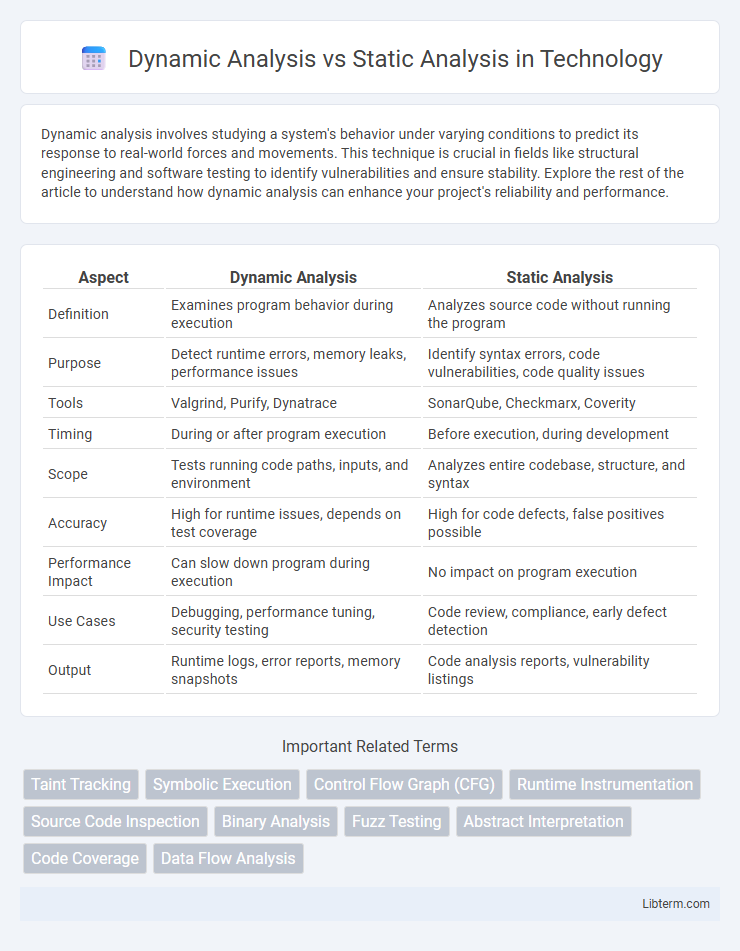Dynamic analysis involves studying a system's behavior under varying conditions to predict its response to real-world forces and movements. This technique is crucial in fields like structural engineering and software testing to identify vulnerabilities and ensure stability. Explore the rest of the article to understand how dynamic analysis can enhance your project's reliability and performance.
Table of Comparison
| Aspect | Dynamic Analysis | Static Analysis |
|---|---|---|
| Definition | Examines program behavior during execution | Analyzes source code without running the program |
| Purpose | Detect runtime errors, memory leaks, performance issues | Identify syntax errors, code vulnerabilities, code quality issues |
| Tools | Valgrind, Purify, Dynatrace | SonarQube, Checkmarx, Coverity |
| Timing | During or after program execution | Before execution, during development |
| Scope | Tests running code paths, inputs, and environment | Analyzes entire codebase, structure, and syntax |
| Accuracy | High for runtime issues, depends on test coverage | High for code defects, false positives possible |
| Performance Impact | Can slow down program during execution | No impact on program execution |
| Use Cases | Debugging, performance tuning, security testing | Code review, compliance, early defect detection |
| Output | Runtime logs, error reports, memory snapshots | Code analysis reports, vulnerability listings |
Introduction to Dynamic and Static Analysis
Dynamic analysis examines software behavior during execution, identifying runtime errors, performance bottlenecks, and security vulnerabilities through techniques like debugging and profiling. Static analysis involves inspecting source code or binaries without execution to detect potential issues such as code quality flaws, syntax errors, and security weaknesses using tools like linters and code analyzers. Both methods complement each other by providing comprehensive insights into software reliability and maintainability.
Key Differences Between Dynamic and Static Analysis
Dynamic analysis involves examining a program during its execution to identify runtime errors, memory leaks, and performance bottlenecks, whereas static analysis inspects the source code without running the program to detect syntax errors, code vulnerabilities, and style violations. Dynamic analysis provides insights into how the software behaves in real-time environments, making it effective for detecting issues like crashes and security exploits, while static analysis offers early bug detection and enforces coding standards before deployment. The key difference lies in dynamic analysis requiring program execution for behavior monitoring, contrasted with static analysis's code-only approach for preemptive defect identification.
How Dynamic Analysis Works
Dynamic analysis evaluates software by executing programs in a real-time environment to detect runtime errors, memory leaks, and performance issues. It monitors system behavior, input-output interactions, and resource usage during execution, enabling the identification of vulnerabilities that static analysis might miss. Tools like debuggers, profilers, and runtime verification frameworks facilitate this hands-on approach to uncover dynamic execution problems effectively.
How Static Analysis Works
Static analysis examines source code without executing the program, identifying potential errors, vulnerabilities, and code quality issues by analyzing the syntax and structure. It uses tools to scan code for patterns that violate coding standards or introduce bugs, enabling early detection of defects before runtime. This method helps improve software reliability by providing insights on possible risks through automated code review and rule-based checking.
Advantages of Dynamic Analysis
Dynamic analysis provides real-time detection of runtime errors, memory leaks, and security vulnerabilities that static analysis might miss. It allows testing of program behavior under actual operating conditions, ensuring more accurate identification of performance bottlenecks and logical flaws. This approach is essential for understanding the effects of dynamic code execution paths, user inputs, and system interactions.
Advantages of Static Analysis
Static analysis offers significant advantages by detecting coding errors, security vulnerabilities, and adherence to coding standards early in the development cycle without executing the program. It enables comprehensive examination of all code paths, ensuring thorough coverage and reducing the risk of runtime failures. This method also improves code quality and maintainability by providing actionable insights before deployment, enhancing overall software reliability.
Limitations of Dynamic Analysis
Dynamic analysis faces limitations such as the inability to achieve complete code coverage, as it only examines the program behavior during specific execution paths and inputs. It requires a runtime environment, which increases resource consumption and can slow down the testing process. Additionally, dynamic analysis may miss latent vulnerabilities that do not manifest during the observed executions.
Limitations of Static Analysis
Static analysis tools often struggle to detect runtime errors and behavioral issues because they analyze code without executing it. These tools may produce false positives, overwhelming developers with warnings that do not correspond to actual bugs. Limited in understanding dynamic code paths, static analysis can miss vulnerabilities emerging only during program execution or interaction with external systems.
Choosing the Right Analysis Method for Your Project
Selecting the appropriate analysis method hinges on project requirements such as the need for identifying runtime behavior or code vulnerabilities. Dynamic analysis excels in detecting memory leaks, performance bottlenecks, and security flaws during execution, while static analysis provides early detection of syntax errors, code quality issues, and potential bugs without running the program. Balancing the benefits of both methods can enhance software reliability, with dynamic analysis favored for complex applications requiring real-time insights and static analysis ideal for quick, automated code reviews during development.
Integrating Both Approaches for Optimal Results
Integrating dynamic analysis with static analysis enhances software security by combining real-time behavior monitoring and code inspection for comprehensive vulnerability detection. Static analysis tools examine source code to identify potential flaws early, while dynamic analysis tests applications during execution to uncover runtime issues. This hybrid approach leverages the strengths of both methods, enabling developers to detect and remediate security risks more effectively and improve overall software quality.
Dynamic Analysis Infographic

 libterm.com
libterm.com